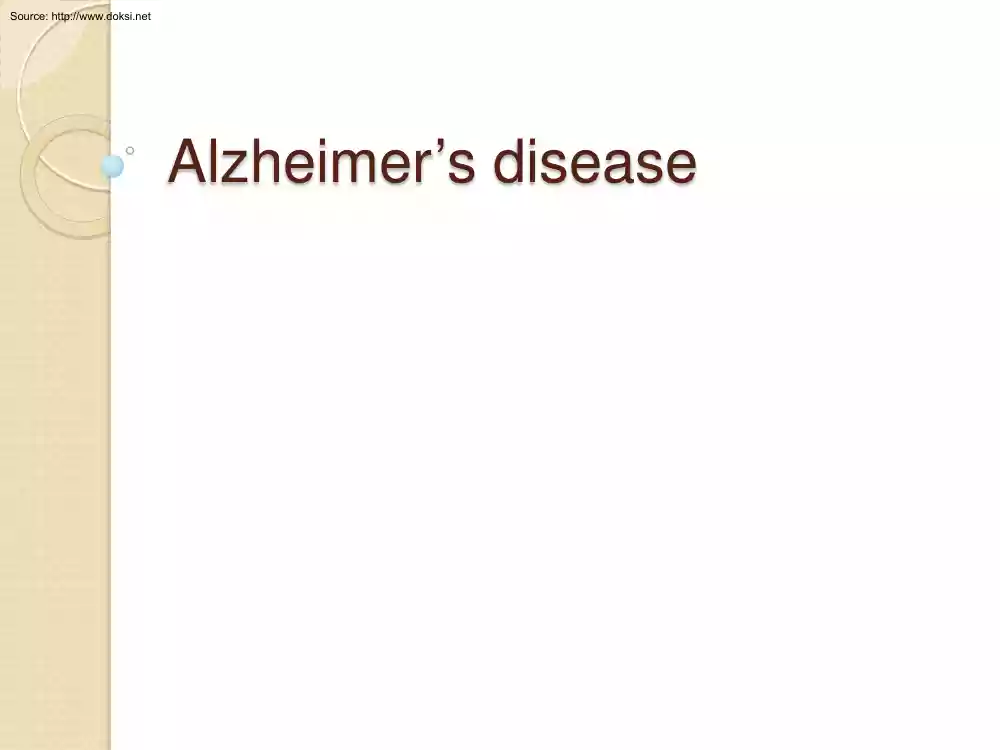A doksi online olvasásához kérlek jelentkezz be!

A doksi online olvasásához kérlek jelentkezz be!
Nincs még értékelés. Legyél Te az első!
Tartalmi kivonat
Source: http://www.doksinet Alzheimer’s disease Source: http://www.doksinet Alzheimer's disease Alzheimer's disease (AD) is a common age-related dementia distinct from vascular dementia associated with brain infarction. The main pathological features of AD comprise amyloid plaques, neurofibrillary tangles and a loss of neurons (particularly cholinergic neurons of the basal forebrain). Amyloid plaques consist of aggregates of the Aβ fragment of amyloid precursor protein (APP), a normal neuronal membrane protein, produced by the action of β- and γ-secretases. AD is associated with excessive Aβ formation, resulting in neurotoxicity. Familial AD (rare) results from mutations in the APP gene, or in presenilin genes (involved in γ-secretase function), both of which cause increased Aβ formation. Neurofibrillary tangles comprise intracellular aggregates of a highly phosphorylated form of a normal neuronal protein (Tau). The relationship of these
structures to neurodegeneration is not known. Loss of cholinergic neurons is believed to account for much of the learning and memory deficit in AD. Source: http://www.doksinet Pathogenesis of Alzheimer's disease Source: http://www.doksinet Source: http://www.doksinet Amyloid is characterized by apple-green birefringence upon polarization of Congo red stained sections Source: http://www.doksinet Romhányi György (1905-1991) Alois Alzheimer (1864-1915) Source: http://www.doksinet Ach level elevation Tacrine, Trials showed modest improvements in tests of memory and cognition in about 40% of AD patients, but no improvement in other functional measures that affect quality of life. Tacrine has to be given four times daily and produces cholinergic side effects such as nausea and abdominal cramps, as well as hepatotoxicity in some patients, so it is far from an ideal drug. Later compounds, which also have limited efficacy but are more effective than tacrine in
improving quality of life, include donepezil, rivastigmine and galantamine. Source: http://www.doksinet NSAIDs Ibuprofen and indometacin have this effect, although other NSAIDs, such as aspirin, do not, nor do anti-inflammatory steroids such as prednisolone. Recent works suggest that NSAIDs may reduce Aβ42 formation by regulating γ-secretase, an effect unrelated to cyclo-oxygenase inhibition, by which NSAIDs reduce inflammation. It may therefore be possible to find compounds that target γsecretase selectively without inhibiting cyclooxygenase, thus avoiding the side effects associated with current NSAIDs. Disappointingly, clinical trials with various NSAIDs have so far failed to show any effect on cognitive performance or disease progression in AD patients Source: http://www.doksinet Mementine (NMDA receptor blocker) Beta-gamma secretase inhibitors (LY- 450139, BMS-289948, BMS-299897)
structures to neurodegeneration is not known. Loss of cholinergic neurons is believed to account for much of the learning and memory deficit in AD. Source: http://www.doksinet Pathogenesis of Alzheimer's disease Source: http://www.doksinet Source: http://www.doksinet Amyloid is characterized by apple-green birefringence upon polarization of Congo red stained sections Source: http://www.doksinet Romhányi György (1905-1991) Alois Alzheimer (1864-1915) Source: http://www.doksinet Ach level elevation Tacrine, Trials showed modest improvements in tests of memory and cognition in about 40% of AD patients, but no improvement in other functional measures that affect quality of life. Tacrine has to be given four times daily and produces cholinergic side effects such as nausea and abdominal cramps, as well as hepatotoxicity in some patients, so it is far from an ideal drug. Later compounds, which also have limited efficacy but are more effective than tacrine in
improving quality of life, include donepezil, rivastigmine and galantamine. Source: http://www.doksinet NSAIDs Ibuprofen and indometacin have this effect, although other NSAIDs, such as aspirin, do not, nor do anti-inflammatory steroids such as prednisolone. Recent works suggest that NSAIDs may reduce Aβ42 formation by regulating γ-secretase, an effect unrelated to cyclo-oxygenase inhibition, by which NSAIDs reduce inflammation. It may therefore be possible to find compounds that target γsecretase selectively without inhibiting cyclooxygenase, thus avoiding the side effects associated with current NSAIDs. Disappointingly, clinical trials with various NSAIDs have so far failed to show any effect on cognitive performance or disease progression in AD patients Source: http://www.doksinet Mementine (NMDA receptor blocker) Beta-gamma secretase inhibitors (LY- 450139, BMS-289948, BMS-299897)




